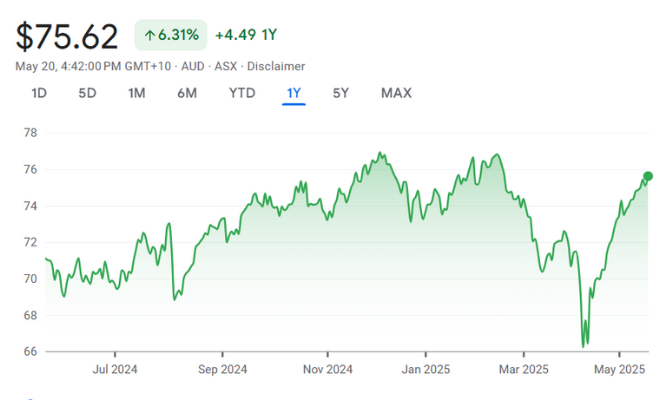SPDR S&P/ASX 200 Fund (ASX: STW)Share Price and News

About SPDR S&P/ASX 200 Fund
Launched in August 2001, the SPDR S&P/ASX 200 Fund (STW) was Australia's first ETF, managed by State Street Global Advisors. The fund aims to closely track the performance of the S&P/ASX 200 Index, which comprises the 200 largest companies listed on the ASX by float-adjusted market capitalisation. This includes major players across various sectors, providing investors with broad market exposure in a single transaction.
STW Company History
Since its inception in 2001, STW has grown to become a cornerstone in the Australian ETF landscape. It was introduced to provide investors with a simple and efficient means to access the performance of the S&P/ASX 200 Index. Over the years, STW has maintained its commitment to low-cost investing, with management fees currently at 0.05% per annum. The fund's longevity and consistent performance have solidified its reputation among both retail and institutional investors.
Future Outlook of SPDR S&P/ASX 200 Fund (ASX: STW)
The outlook for STW is intrinsically linked to the performance of the Australian equity market. As of 30 April 2025, the fund reported a 1-year total return of 9.82%, closely mirroring the S&P/ASX 200 Index's return of 9.79%. Over a 5-year period, STW achieved an annualised return of 12.10%, demonstrating its effectiveness in tracking the benchmark.
The fund's estimated 3–5 year earnings per share (EPS) growth stands at 5.77%, indicating moderate growth expectations for its underlying holdings. With a dividend yield of 3.56% and a price-to-earnings ratio of 18.56, STW offers a balanced mix of income and growth potential. Given its diversified portfolio and low management costs, STW is well positioned to continue serving as a core holding for investors seeking exposure to the Australian market.
Is STW a Good Stock to Buy?
STW presents a compelling option for investors aiming for broad exposure to the Australian equity market. Its low management fee of 0.05% per annum enhances its appeal, especially for cost-conscious investors. The fund's strong track record, with a 10-year annualised return of 7.59%, underscores its effectiveness in tracking the S&P/ASX 200 Index.
The quarterly distribution schedule, combined with a dividend yield of 3.56%, offers regular income, which can be particularly attractive for income-focused investors. Moreover, the fund's diversified holdings mitigate company-specific risks, providing a level of stability in volatile markets. However, potential investors should be aware that STW's performance is tied to the broader market.
Therefore, during market downturns, the fund's value may decline in tandem with the index. Nonetheless, for those seeking a low-cost, diversified investment aligned with the Australian market, STW remains a strong candidate.
Our Stock Analysis
Is your company’s management good or bad? Here are 3 ways to judge
Management makes or breaks a company, especially a listed one. It is easy to look at a company’s past and…
Ageing population stocks are set to derive significant long-term value
Ageing population stocks represent among the best long-term opportunities that exist for investors. Over the next 25 years, the world’s…
Why have food delivery stocks been dud investments despite brutal consumer demand during COVID-19?
During the height of the COVID pandemic, we couldn’t dine out so we turned to food delivery companies – including…
Why did biotech shares underperform in 2022 and will they rebound with a vengence in 2023?
In the past year, biotech shares have performed poorly. Why has this been the case and will things be better…
Luxury fashion retailer Cettire (ASX:CTT) has ~60% upside
Cettire (ASX:CTT) has been a volatile company ever since its late-2020 listing. It is an online luxury goods retailing business…
ASX coal stocks have had a terrific 12 months…but where to now?
ASX coal stocks have been among the hottest stocks on the ASX in the last 12 months. The key catalyst…
Frequently Asked Questions
As of 30 April 2025, STW offers a dividend yield of 3.56%, providing investors with regular income distributions.





